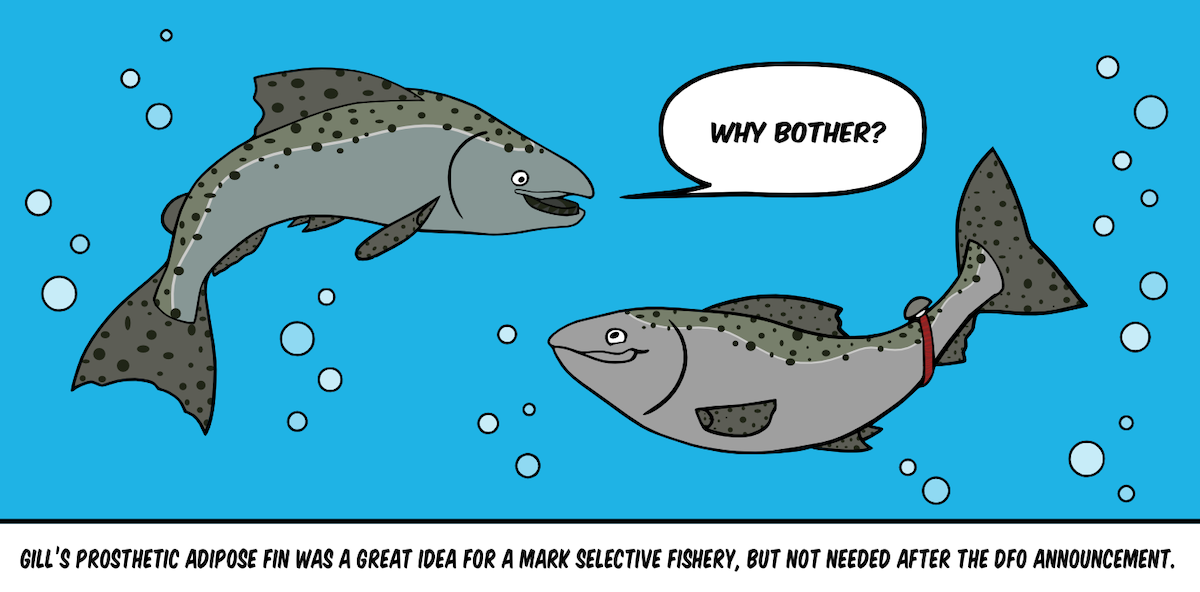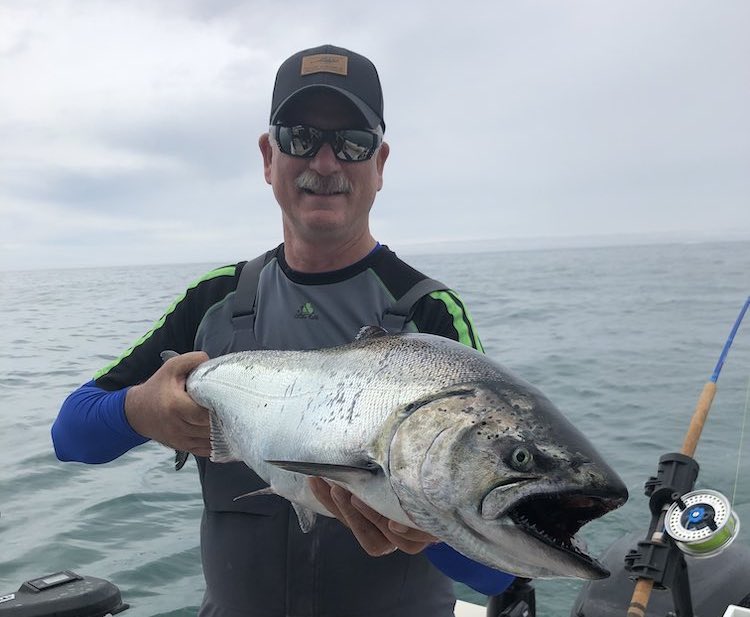
On June 19, the Government of Canada released new management measures for struggling Fraser River Chinook populations. “These fishing plans are one component of a larger strategy intended to place at risk Pacific salmon populations on a path towards sustainability,” said the release, which goes on to say “Fisheries and Oceans Canada took unprecedented fisheries management measures in 2019 to protect Fraser River Chinook, including efforts to clear the Big Bar landslide” but “more is needed.”
In 2019 actions included unprecedented Chinook non-retention in the public fishery that remained in place until July 15 for most of southern BC’s marine waters and as long as July 31 for some areas, along with river recreational fishery closures until August 23. According to Fisheries and Oceans, the 2020 plans were developed in consultation with Indigenous communities, recreational and commercial fishing organizations, and environmental organizations and are intended to “support the recovery of at-risk Fraser River Chinook stocks, as well as protect the jobs and communities that depend on Chinook.” According to Fisheries and Oceans, there is only one wild salmon population of thirteen on the Fraser that is not at risk.
“Pacific wild salmon are an icon of our West Coast and protecting them is a top priority,” said Federal Fisheries Minister Bernadette Jordan. “The measures announced today are one of many actions we are taking to protect and restore wild Pacific salmon. Indigenous and coastal communities depend on this stock for their food and livelihoods, and we are moving forward with a stringent, but flexible approach that reflects those needs.” In support of this statement, Fisheries and Oceans laid out the keys for recovery, which include habitat protection, habitat restoration, climate adaptation, improved stock assessment, and enhanced science and collaboration.
Here are the 2020 measures that came in to effect for the public fishery:
A small number of terminal and non-Fraser Chinook retention opportunities are under consideration and may be announced in a separate Fishery Notices.
WCVI Subareas 20-1, 20-2, Area 121, and seaward of a 1nm boundary line in Areas 123 to 127
- Apr. 1 to Jul. 14: No retention of Chinook
- July 15 to July 31: 2 Chinook per day, max 80 cm.
- Aug 1 to Dec 31: 2 Chinook per day
Full coordinates can be found in FN0565. For clarity, Chinook daily limits remain at 2 per day shoreward of this boundary line, and also in Areas 21 to 27.
Queen Charlotte Strait and Johnstone Strait
Area 12, excluding Subarea 12-14:
- April 1 July 14: No retention of Chinook in the majority of Area 12
- July 15 to August 16: 1 Chinook per day, max 80 cm.
- Aug 17 to Aug 31: 1 Chinook per day
- Sept. 1 to Dec. 31: 2 Chinook per day
For clarity, Chinook daily limits remain at 2 per day in Area 11 and Subarea 12-14.
Strait of Georgia – North
Areas 13 to 17, Subareas 29-1 and 29-2:
- April 1 to July 14: No retention of Chinook
- July 15 to Aug 31: 1 Chinook per day, max 80 cm
- Sept 1 to Dec 31: 2 Chinook per day
Strait of Georgia – South and Juan de Fuca
Areas 18, Subareas 19-3 to 19-12, Subareas 20-3 to 20-7, Area 28 and Subareas 29-3 to 29-5 (with the exception of those portions of Areas 28 and 29 listed below), and Subarea 29-8:
- April 1 to July 31: No retention of Chinook
- Aug 1 to Aug 31: 1 Chinook per day, max 80 cm
- Sept 1 to Dec 31: 2 chinook per day
Portions of Southern Strait of Georgia, Howe Sound and Burrard Inlet
Full coordinates can be found in FN0565.
- April 1 to Aug 31: No fishing for Chinook
- Sept 1 to Dec 31: 2 Chinook per day

Map of management actions for West Coast Vancouver Island Offshore, Johnstone Strait, Strait of Georgia and Juan de Fuca
BC’s recreational fishing business interests and anglers have been waiting anxiously for this release, buoyed by the hope that some elements of a detailed management plan, if not the entire plan, that was developed jointly by the Department of Fisheries and the Sport Fishing Advisory Board would be incorporated in the 2020 regulations. This plan was based on assessing the most up-to-date coded wire tag, DNA, and run timing data for these stocks of concern.
After extensive research and effort, the Department of Fisheries and Oceans Canada (DFO) and the Sport Fishing Advisory Board (SFAB) arrived at a science-based solution that would provide more fishing opportunities in areas where there were no impacts on weak Fraser River Chinook stocks, or where there were minor impacts that could be mitigated by allowing for the retention of hatchery-marked salmon, special size limit regulations, time and area closures, or combinations of all three of these management tools. This was done to avoid a repeat of the severe losses the recreational fishery experienced in 2019 while meeting this year’s conservation goals for these valuable stocks.
The response from those in the public fishery to the 2020 regulations has been one of near-universal disappointment.
“We have provided DFO with the most extensive DNA sampling of any area in BC and the results prove that interception rates of Upper Fraser Chinook are minimal,” says Bob Meyer has operated his Gabriola Island charter fishing business for decades. “We also have a 40% hatchery Chinook rate in area 17 in April and May, which should allow for a hatchery-retention fishery. These Upper Fraser stocks have been of concern for decades, and DFO has done nothing proactive to enhance these stocks.”
His view is supported by the Sport Fishing Institute of BC. “Sadly we find ourselves in a bad déjà-vu moment, only further into the season and with the situation exacerbated by the COVID pandemic,” said the organization in a press release. “Today, the department has largely ignored important advice and specific plans and data collected by the public fishery, with DFO staff, to implement a balanced approach to form a 2020 Fraser River Chinook plan.”
Dave Brown is a well-known lower mainland fisherman who has received national recognition as an angler and conservationist and is involved in salmon enhancement activity on the Squamish River system. His comments were short and to the point: “This decision was based purely on politics and has no scientific basis. If less than a 1% impact (referring to Howe Sound and adjacent areas that are now under Chinook non-retention until August 31) is not good enough, then where do we go from here? Fisheries Minister Jordan has stopped managing based on science and data.”
Chris Bos from Victoria heads the South Vancouver Island Anglers Association. Four years ago this group, with DFO approval, began a program to raise hatchery Chinook to increase the food supply for Southern Resident Killer Whales as they forage the waters of Juan de Fuca Strait. It is the only program of its type on the coast and is almost entirely self-funded. “With great frustration, I note the Fisheries Minister has again opted to ignore the Sport Fishing Advisory Board’s advice,” Bos said. “This is more evidence that BC’s small coastal communities and the public who salmon fish are NOT important to Ottawa.”
“The public Chinook fishery, which is critical to the BC’s marine fisheries, cannot survive on catch-and-release fishing,” he added. “Allowing Canadians to keep a hatchery-marked fish principally of U.S. origin would have no measurable impact on any Fraser stocks of concern.”
Grant MacPherson is president of the Sidney Anglers’ Association. This relatively small club packs a punch when it comes to salmon restoration and enhancement. They have their own successful coho restoration project but have additionally raised approximately $200,000 for regional salmon projects in the last decade, according to club executive Shirley Johnson. “The Sidney Anglers are extremely disappointed by this badly timed decision that affects fishing in areas 18 and 19,” MacPherson said. “Why were all the proposals over the last two years ignored by DFO’s upper management staff? It is apparent that the Minister never received the carefully prepared information package. Canadians, in particular western Canadians, are being marginalized and disregarded by Ottawa.”
Pat Ahern is president of the West Coast Fishing Guides Association, and his comments provide an excellent summary of public fishery opinion. “Sadly, these measures have more to do with playing politics than following science,” said Ahern.

Pat Ahern and a June 2020 Hatchery Chinook
“Chasing the shiny penny of implementing fishery restrictions to recover stocks is a failed strategy—we know this from our 20-year experience to recover interior Thompson coho without success. Restrictions are nothing more than placing lipstick on the pig, and this government has failed to make strategic investments such as habitat improvement, water quality, enhancement, and predator control that address the real causes of Chinook declines. This government took the cheap way out, and their so-called bold investment will amount to nothing more than standing back and watching this stock dwindle to extinction.”
4 Comments
Leave A Comment
Visit the Store
$34.99
$34.99
Featured Catch

Joel Unickow halibut (Photo: Rob Frawley Lucky Strike Sportfishing Tofino)








the same stall tactics we are receiving from DFO head office for our IFMP to harvest pinnipeds and bring them back into historical balance. The;re have been literally millions of $ spent over the last few years that clearly show that pinnipeds consume 50 to 85% of outbound chinook smolts. A new study just released shows that sea lions on the lower Columbia consume 3 to 5 chinook/day on inbound adult. Dr Carl Walters, UBC is puitting the finishing touches on a study stating that the B.C. Stellar sea lion populations consume 300,000 metric tons of fish/year.
4.2 and 5.2 outbound Fraser chinook are prime targets for seals due to their size being 2 year olds. Same story for Chilcotin and Thompson steelhead smolts.
These poorly enacted restrictions are merely a bandaid solution to a problem that needs to be met head on. 50,000,000 chinook come out each year to have 25,000,000 to 40,000,000 eaten by seals.
Dr. Walters states that 50% of the coho smolts suffer the same demise.
We have a plan and all needs in place to employ people and bring the pinnipeds back into balance and greatly reduce the carnage. DFO simply needs to approve
Totally agree especially the last paragraph. Also stop the commercial herring fishery.
i have seen fish swim up water falls and the slide as a waste money why can we not have some common sence fishing licence what a farce last minute changes right fire the lot catch and release not good either high mortality so commercial get it all more shite to all who buy a licence shame for the rip off
The sealions can come and go and eat their fill of salmon at will , the cormorants can eat their fill of salmon smolts till they cant fly , the mergansers can eat their fill of fry in the riverbeds unmolested , but the citizen who built their country with blood sweat and tears must beg the king on bended knee to just put a salmon on his family’s table .